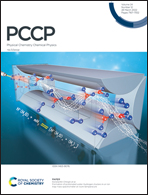From gaseous HCN to nucleobases at the cosmic silicate dust surface: an experimental insight into the onset of prebiotic chemistry in space†‡
Abstract
HCN in the gas form is considered as a primary nitrogen source for the synthesis of prebiotic molecules in extraterrestrial environments. Nevertheless, the research mainly focused on the reactivity of HCN and its derivatives in aqueous systems, often using external high-energy supply in the form of cosmic rays or high energy photons. Very few studies have been devoted to the chemistry of HCN in the gas phase or at the gas/solid interphase, although they represent the more common scenarios in the outer space. In this paper we report about the reactivity of highly pure HCN in the 150–300 K range at the surface of amorphous and crystalline Mg2SiO4 (forsterite olivine), i.e. of solids among the constituents of the core of cosmic dust particles, comets, and meteorites. Amorphous silica and MgO were also studied as model representatives of Mg2SiO4 structural building blocks. IR spectroscopic results and the HR-MS analysis of the reaction products revealed Mg2+O2− acid/base pairs at the surface of Mg2SiO4 and MgO to be key in promoting the formation of HCN oligomers along with imidazole and purine compounds, already under very mild temperature and HCN pressure conditions, i.e. in the absence of external energetic triggers. Products include adenine nucleobase, a result which supports the hypothesis that prebiotic molecular building blocks can be easily formed through surface catalytic processes in the absence of high-energy supply.

- This article is part of the themed collection: 2022 PCCP HOT Articles


 Please wait while we load your content...
Please wait while we load your content...